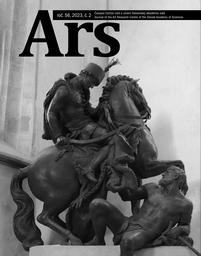Poznámky k ikonografii a ikonológii scény rozdávania milodarov sv. Jánom Almužníkom
Notes on the Iconography and Iconology
of the Scene of Distributing Alms by St. John the Almsgiver
Author(s): Marian Zervan, Vratislav ZervanSubject(s): Fine Arts / Performing Arts, Visual Arts
Published by: Slovenská akadémie vied - Centrum vied o umení
Keywords: iconography; iconology; St. John the Almsgiver; charity; almsgiving; crypto portrait; Gustav Adolf Müller; Joseph Kurtz; Sebastian Zeller
Summary/Abstract: The study is a contribution to the iconography of St. John the Almsgiver. The paper focuses on the copper engravings and the painting of Joseph Kurtz from the 18th century in Slovak collections, which depict St. John the Almsgiver distributing the alms. While writing the study, we gradually discovered that to explain the etchings and the painting, we need to examine the origins of this iconographic theme. It was confirmed that the form of the representative portrait of St. John Almsgiver originated in Byzantium. Byzantine psalter illuminators undoubtedly created the essential iconographic attributes with portrait features of the scene. However, it is also indisputable that the transfers and robberies of the saint‘s remains before and after 1204 contributed significantly to the cult of the saint in several places in the Latin West. An important factor in consolidating the cult was the saint‘s inclusion in the Golden Legend hagiographic collection. This collection‘s illustrated manuscripts and first prints undoubtedly influenced the composition of the iconographic scene of the distribution of alms by St. John the Almsgiver. The Hungarian king Matthias Corvinus, who received the entire body of St. John Almsgiver most probably based on the peace treaty, and his court had contributed to the extraordinary promotion of the cult of the saint. Thanks to the painted decoration of the chapel in Buda, where the remains of the saint were kept, visual representations inspired by the Golden Legend collection spread not only in the territory of today‘s Slovakia but also in several places in today‘s Poland. Only the paintings of the 16th and 17th centuries prioritized the iconographic scene of giving alms to such an extent that most of their elements were adopted by Gustav Adolf Müller. In the representative crypto portrait of Joseph Kurtz, the beggars are strikingly similar, as if they were a multiplication of the exact figure. If we accept such an interpretation, the question of the reason for such a procedure arises. A hypothesis could be made that the painting was a mixture between a representative portrait and a narrative image.
Journal: ARS
- Issue Year: 56/2023
- Issue No: 2
- Page Range: 185-208
- Page Count: 24
- Language: Slovak

